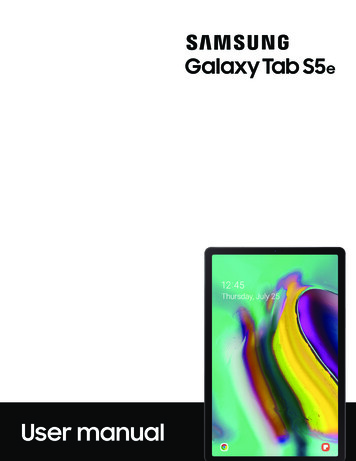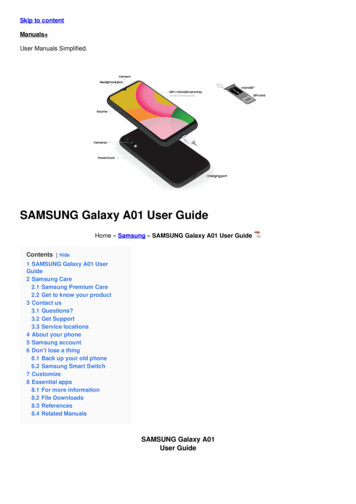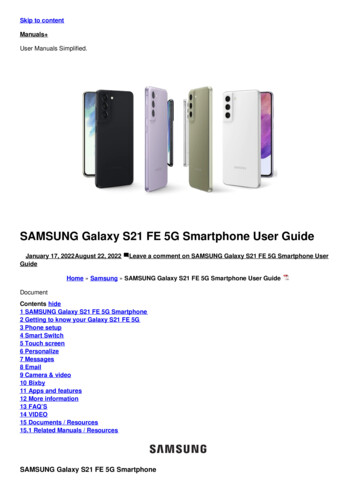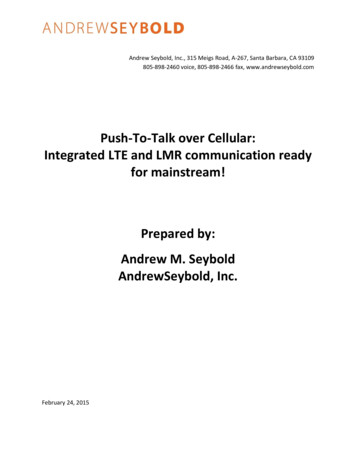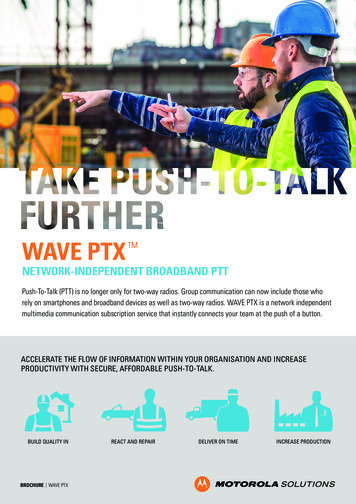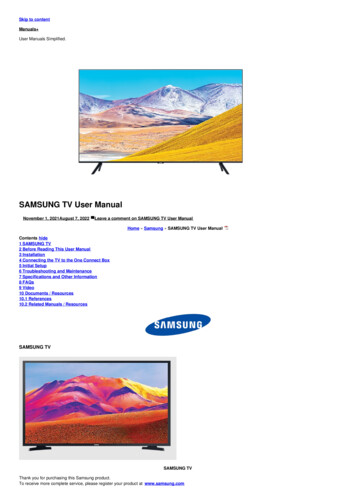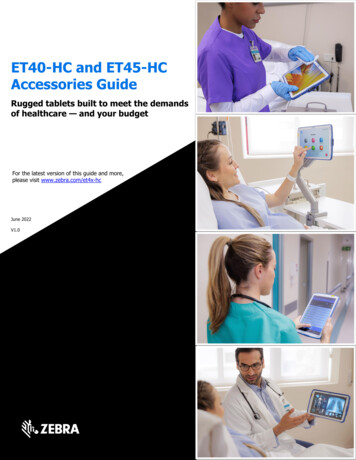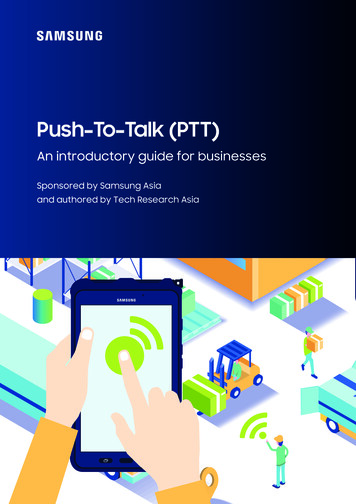
Transcription
Push-To-Talk (PTT)An introductory guide for businessesSponsored by Samsung Asiaand authored by Tech Research Asia
IntroductionThis guide covers the fundamentals of Push-to-Talk (PTT) including thecurrent state of the market, device characteristics, key players and some ofthe common use cases. It is designed as an introduction for people notfamiliar with PTT solutions or the market.In January 2020 TRA conducted a survey of over 1300 businesses in eightcountries (Australia, Indonesia, Malaysia, New Zealand, Philippines,Singapore, Thailand and Vietnam) to understand their usage and views ofPTT. Throughout this guide, we will reference relevant data from that surveyto provide additional insights.Except where otherwise indicated, the information contained in this guide isbased on TRA's research and survey.02
Tableof Contents81Executive SummaryHow are PTT projects implemented?2What is Push-To-Talk?3What is the market context?4What does the PTT vendor landscape look like?9What are the outcomes that can be expected?5Which market sectors or industries are mostlikely to adopt PTT?10What is the future of PTT?11A checklist for businesses to consider ifassessing PTTExample 1 – Mining Operations6What are the business drivers for PTT?7What are the desired characteristicsof an PTT solution?Example 2 – Stadium Event ServicesExample 3 – First Responders03
1Executive SummaryPush-to-Talk (PTT) solutions that use contemporaryrugged smartphones and tablets seek to replace LandMobile Radio (LMR) devices like walkie-talkies.The supply side of the market is evolving quickly with bothtraditional vendors, telco service providers and softwarestartups driving awareness and investment.PTT solutions are multi-purpose and offer far moreopportunities to be productive with multimedia, locationtracking and extensibility than traditional LMR systems.They work over broadband networks like LTE and WiFi.The most likely adopters are in industries that have highsafety requirements with hazardous environments or withlarge campus style environments.PTT investments are often driven by a desire for improvedsafety and while agile approaches to implementation arebeing sought, projects are often long and hampered bytender requirements.The future of the PTT market is bright. We see significantinterest in modern solutions to replace LMR systems. Thetechnology will also evolve further to integrate artificialintelligence tools and wearable devices.59%of companies surveyed acrossthe region say they are currentlyusing a push-to-talk (PTT)solution. However, adoption ratesin our view are likely much lowerwith some misunderstanding ofwhat PTT entails.44%would prefer to use asmartphone for their PTT needsand 44% plan to adopt furtherPTT solutions in future.“In today’s business environment,rugged devices need to be capable ofperforming more than one dedicated role.”Totally agree 35%Mostly agree 33%Partly agree 21%Partly disagree 6%Mostly disagree 5%Totally disagree 1%04
2 What is PTT?Push-to-Talk (PTT) is a set of technologies that is used to equip modern mobile devices (andPersonal Computers) with the capabilities of a “walkie-talkie”.There are important differences between what walkie-talkies can do and what modern PTT can achieve.For example, with traditional walkie-talkie systems: Users called talk to each other with a single purposedevice like a walkie-talkie, radio, etc using radiofrequencies (in UHF and VHF bands). This is called a landmobile radio (LMR) system. The range of LMR devices is typically limited toaround 30 to 50KM from a base station with line of sight.Although this can be extended with a repeater, dedicatedinfrastructure must be installed to enable a wide enoughcoverage area for the LMR to be useful. However, thereare no additional call or data costs. Anyone that isn’t within range is not able tocommunicate using the system. Although data can be sent over an LMR with digitalmodulation, the vast majority of communications arevoice only.1. PTT over cellular or PoC.2. Broadband PTT.3. Mission Critical PTT or MCPTT (However, we willstick to just using PTT). Let anyone with an internet connection anywhere in theworld – with the right permission – to join a PTT group orprivate conversation. Differ from walkie-talkies in that they are multi-purpose(video, voice and data) and not single-use voice onlydevices. Are most commonly used with rugged mobile deviceslike smartphones or tablets. They will usually haveprogrammable quick access buttons and be able to beused with gloves in wet conditions. These can also becomplemented by traditional radio devices or clip ondevices that help with hands-free working. Frequencies that LMR systems use are typically overseenby government agencies and some spectrums arededicated solely for military or public safety purposeswhile others are sold to commercial interests via alicense. Interference can happen as a result of unauthorised orunlicensed use of a frequency. Monitoring of communications could also happen bythird parties via “scanners”. Encryption is relatively poor.In comparison, modern PTT systems: Leverage cellular and mobile networks including 4GLTE, Wi-Fi, Satellite broadband, and Bluetooth to enableusers to communicate with each other. This has led toother terms that are frequently used in the market:05
Are software driven and can be used on any device.Indeed, there are many free consumer-grade PTT appson both the Android and iOS platforms. However,enterprise-class PTT solutions typically require muchmore rugged device specifications as they are usedoutdoors or in more demanding environments. Have standards that have been set by the globalorganisation 3GPP, especially for mission critical PTT. Allenterprise-level PTT solutions should meet thesestandards. Allow speaking to be one-to-one or one-to-many and isalmost immediate (no waiting for a dial tone or call toconnect). The conversation is like a walkie-talkie, meaningonly one person speaks at a time but modern apps includequeuing and often a hierarchy of speakers where those incritical control positions can override a conversation. Have multimedia communication where users can sharevideo and data-heavy information in real-time. All communication can be encrypted with the higheststandards. Changes the end user experience. The way it all works isthey download the nominated PTT app (or haveit installed for them by the IT department) to theirdevice (likely a rugged smartphone or tablet). They willhave contacts and groups set up on the app that arepresented as icons. This allows them to simply “push” (orclick) an icon or programmed device button where theycan start talking to the person or group they want tospeak to as long as they have an internet connection. Include geolocation tracking of multiple assets withnavigation capabilities. Integrate into existing dispatch systems or newer digitalversions Integrate into productivity suites like Microsoft Teamsapplication. For example, Samsung’s walkie-talkieapplication leverages existing channels in a company’sTeams site. It allows employees to use a Galaxy XCoverPro and talk to their existing contacts and groups inTeams in the same manner as a walkie-talkie. Integrate with artificial intelligence (AI) or machinelearning-based workflows and translation. Integrate with wearable devices like smartwatches. At the back-end will require a server that controls theflow of traffic over the network. This may be a physicalserver that sits in an organisation’s data centre or onehosted on a cloud computing platform like Amazon WebServices (AWS) or Azure. Increasingly, organisations donot need to set this up themselves but instead can takeadvantage of a PTT solution “as-a-service” whereeverything on the back-end is done for them. Offer a Management Console that enables administratorsFigure 2 Samsung Galaxy Pro Active Tab with Orion PTT app The internet connectivity approach means they don’thave to be physically within the range of an LMRnetwork and it is easier to communicate with peoplein other organisations unlike with older walkie talkiesystems which made this hard to achieve.to control every aspect of the system: permissions,security, governance, updates, analytics, etc. Thisincludes asset tracking of devices along with preventivemaintenance. Offer APIs to allow 3rd party applications to be integrated06
Finally, it will also deliver interoperability with existingLMR or PTT solutions. This final point is important as it ishighly unlikely that LMR systems will stop being used inthe near future. They are too valuable (both as a primaryand secondary option for emergency communications)and have too much existing investment in them. ModernPTT systems have to be able to bridge between LMRdevices. Interoperability is often achieved by allowinga walkie-talkie or radio to connect to a portable basestation. This then allows the user to communicate overtheir LMR network via their rugged device within themodern PTT app.The characteristics of Land Mobile Radio and Push to TalkLand Mobile Radio(LMR)Push-to-Talk(PTT)Type: SpecificDesign: BulkyPTT Button: AvailableSingle use devicesDeviceType: Mobile deviceDesign: VariousPTT Button: Depends on deviceRugged devices with voice, dataand video capabilitiesType: DedicatedLMRData: UnavailableNetworkType: Commercial cellularData: 3G/4G/5G/LTE/Wi-FiArea: Limited depends on radio networkAdditional costs: Yes (for repeater)CoverageArea: Wide, depends on cells & Wi-Fi networkAdditional costs: NoFrequently able to be monitoredby 3rd partiesSecurityQuantity: Up to 70Allocation method: Manual or computerizedChannelEncryption possible at all levelsQuantity: Almost limitlessAllocation method: Computerized& cloud basedBuilt-inPTT FunctionVarious PTT App OptionsWired headsetAccessoriesWired & Bluetooth headsetBluetooth speakerN/AOthersLocation TrackingAI WorkflowsSoftware integregrations with APIsCustom applicationsSource: TRA South East Asia & Oceania Rugged Study, 2020.” To “Source: Tech Research Asia Ruggedized Smartphones & Tablets in Asia Pacific research, April 202007
3 What are the markettrends?PTT in the form of walkie-talkie systems have been around for a long time and have proven their worth,especially in industries that need these solutions (more on that later). However, there is now considerablegrowth and development happening in modern PTT systems that are tied to rugged devices.TRA market analysis suggests the global PTT market willdouble in size by 2025, with Asia Pacific expected to be thefastest growing region. SEA markets – excludingSingapore – will be growing from a very low base so whilethe growth rate may be high, the actual volume will be lowcompared to other places like North America, Europe orJapan.But why such strong global forecasts for growth?Several trends are driving investment from vendorsand adoption by users including: Widespread adoption of smartphonesThe widespread adoption of smartphones across theregion and associated connectivity (eg. WiFi and 4G LTE)among business users is leading organisations to seehow they can better leverage the technology. Instead ofan employee having multiple devices (one being awalkie- talkie or LMR device) they are consideringintegrating everything onto the one rugged device. Communication during EmergencyThere is a perception and some indications that naturaldisasters, terrorism and crime rates are increasing.Responses to this requires cross-agency and-organisation coordination and communication. In thepast, communication was sub-optimal during times ofcrisis. Modern PTT systems can provide a resolution. Occupational health and safetyContemporary technologies like PTT are proving thathigher levels of safety for workers is possible especiallyin potentially dangerous situations. This is a focus formany companies that operate in harsh environments.Samsung XCover Pro rugged device with PTT08
Smart CitiesSmart city initiatives often include budgets for increasedpublic safety measures and data analytics programs.The location capabilities of PTT solutions andmultimedia features on devices enable moreopportunities to support such initiatives. ProductivityThere is an ongoing push to improve employeeproductivity and reduce manual interruptions toworkflows in organisations of all types. Voice CommsVoice communication remains a desired part of day-today employee activities. As such, many are looking tohow they can improve the voice experience.09
4 What does the PTT vendorlandscape look like?The supply side of the PTT landscape remains somewhat fragmented with simple apps for consumersthat want a walkie-talkie experience at one end, and full stack solutions for enterprises andgovernments at the other end. Leaving aside the consumer portion of the market, most PTT solutions areactually a combination of different vendor products and services. And modern solutions are evolvingquickly, so there are several startups emerging and acquisitions taking place although little of this isoriginating in Southeast Asia and Oceania.In one corner of the market are the telecom service providers like Telstra and Korea Telecom (along with many in NorthAmerica, Japan and Europe). Generally speaking, telcos aim to boost the use of their networks and capture services revenuefrom PTT adoption. They will package everything together (devices, software, networks and backend infrastructure)and offer governments and enterprises an as-a-service solution.1Telecom Service ProvidersSuch as Korea Telecom, Telstra2TabActive23SoftwareVendorsSuch as Orion Labs,Zello, Virtual TrunkHardware Device ManufacturersSuch as Samsung Electronics10
In another corner are the software application vendors.The focus of these vendors is typically to be a device andplatform agnostic player that can integrate with older LMRsystems. That said, recent trends are for many of theseplayers to also offer their own rugged devices and evolveinto a full stack provider. They often target their solutions atpublic safety agencies and also companies with hazardousenvironments while appealing to the workforce productivityangle. Examples of the software players include: Orion Labs,Zello and Virtual Trunk.The final group of vendors are the device manufacturers orintegrated players. There are a number of vendors in thisspace, some offering basic solutions and others (such asSamsung) that provide an integrated device and softwareplatform. The survey data suggests that users are lookingto vendors that provide an expansive device range thatblends performance, aesthetics and security integrationwith consumer friendly usage.11
5 Which market sectorsor industries are most likelyto adopt PTT?Just as walkie-talkies can be used by any consumer or employee for voice communication in any situation, sotoo can PTT be used. However, while some vendors are marketing to both personal and professional situations,the main adoption of PTT at first will follow the same industries that have used LMR systems. These include:Public Safetyfor first responders like police, ambulance, fire brigadeMilitarypotentially in both operational theatres and non-operationalTransportation and logisticsfor railways, airports, shipping, and automotive (e.g. towing)Distribution and Warehousingfor pickers in warehouses to provide hands-free workingManufacturingin factories and tied to smart factory projectsMining, Oil and Gason project sitesHealthcareespecially on large campuses like hospitals12
Event Servicesat convention centres and stadiumsConstructionparticularly on large-scale projects such as infrastructurebuilds or greenfield housing developmentsUtilitiesfor all types that have plants and in field workers acrossenergy, water, waste management, etcField service workersfor maintenance or engineering of all typesRetailparticularly in large storesGaming and Hospitalityparticularly for casinos and also hotelsFacilities managementincluding shopping centres and other commercial buildings13
6 What are the businessdrivers for PTT?LMR systems have been reliable and delivered benefits to users for many years – they are a fundamentaltechnology for many different types of workers in many industries. So why move to PTT now? It is thequestion that many decision makers face today as more and more vendors promote newer solutions.As with all technology investments there are common triggers that will lead to a PTT project.The Standard Common DriversDigital TransformationThese range from a new leader bringing ina new strategy, an expansion/consolidationof an organisation’s operations or a merger/acquisition, a productivity and/or cost savingdrive, through to device end of life refreshcycles. All are valid drivers for PTT investments.Other drivers will include, however, digitaltransformation programs that include someform of “Smart X”. Sometimes this will alsoinclude newer innovation steps like hackathonsor design thinking workshops where ideas of“how to work in future” are generated.The Security and Safety DriverSmart Cities and Safer EventsHowever, in many circumstances PTT solutionsare not implemented with a view to makinga profit or a financial return on investmentthat frequently underpin the common driversabove. Yes, that is always welcome. But PTT isoften aimed at mission critical environmentswhere safety and security via communicationsare paramount.Reactions to or planning for an increase innatural disaster, terrorism or crime events.Or other large-scale events being held in acity, for instance the SEA Games.We should note that PTT on smart devicesis able to achieve higher levels of securitywith biometric access and encryption of datacompared to LMR systems. This will often bethe top driver and cannot be understated.Greater visibility and insight that providesimproved levels of management ofoperations is another factor that is included inPTT decision making.Data Privacy and RegulationsWhile not necessarily a direct driver there arealso several data and privacy-relatedregulations across SEA and ANZ that arerelevant to the adoption of PTT, especiallyif the solution includes broader feature setslike geolocation tracking. Furthermore,the systems will need to comply withany regulations regarding recording ofcommunications.14
7 What are the desiredcharacteristicsof a PTT solution?We’ve already covered many of the features of PTT solutions above. However, the chart below outlinessome of the factors that users in SEA and ANZ believe are important. Approximately 50% ofrespondents say they want it to be useful in a wet environment, have a dedicated button on the device,be easy to use with gloves on and have on-screen activation.When using PTT, what factors are important?56%51%54%49%42%26%Easy touse whenwearingglovesEasy touse in wetenvironmentsDedicatedbutton tivation16
Furthermore, we also askedabout devices and 44% ofrespondents said they wouldprefer a smartphone as aPTT device.And when asked to rank the desired characteristics ofa PTT device, respondents to our research indicated thefollowing ranking:RankTop 10 PTT device attributes1Connectivity.2Integrated security & device management.3IP Ratings.4Quick access button.5Device design.6Wireless charging.7Available accessories.8Scanning capability.9Using screen when wet.10Dual SIM.Other desired characteristics are shown in the following chart:What are the opportunities for PTT in your company, excluding ‘walkie-talkies’? (Total All)59%58%53%44%43%22%Intergratinginto businessprocessesSharing oflocationIncorporatemultiplesolutions on asingle eLanguagetranslation17
8 How are PTT projectsimplemented?Implementation timelines for projects vary ofcourse depending on the use case and size of theorganisation. Due to the varied nature of SEA theadoption of PTT will be a mixture of replacementor modernisation endeavours and greenfielddeployments. In ANZ (and Singapore) it is morelikely to be the former alone.Notably, there are many organisations –commercial and public and particularly indeveloped markets like Singapore, Australia andNew Zealand – that are going agile with their ITinvestments. These organisations want fast proofof concepts, that can be quickly turned into aprogram of dedicated sprints undertaken quarterly.Implementation timelines however are quite longand can extend longer than one year. Furthermore,PTT projects are frequently subject to slow andbureaucratic official tender processes across SEAand ANZ. This despite the as-a-service model andoff the shelf solutions being available.Use Case 1 – Mining OperationsThis first mini-case study example is based on a globalmining giant. They use a rugged device like the SamsungGalaxy Tab Active Pro with a PTT service that includesvoice-powered automations to automate safety checklistsfor mine workers. With a lack of communications in someareas of the site, including in underground locations, theybuilt out a site-wide WiFi network. Since then, they havebeen able to use PTT for general voice communications in ahazardous environment.The miners were also able to use a voice-activated trigger tostart a safety checklist. The AI-assistant converses with theworker until they are able to complete the checklist. This isthen logged and distributed to management. This has nowbeen done for several standard operating procedures. Theyhave also enabled location tracking to ensure that workersare kept safe in the field and don’t accidently walk or driveinto danger. Overall the aim was to improve occupationalhealth and safety.Open Cut Mining PTT18
Use Case 2 – Stadium Event ServicesWhenever you have thousands of people attendinga sporting or music event, you need a well-tunedcommunications system in order to coordinate the workerswho make these make these events happen. Instead of,for example, food and beverage staff using loudspeakersystems or land lines to request additional help or stockwhen things get busy, with a PTT solution they couldimmediately request assistance by broadcasting to adedicated group. Managers could also track where theiremployees are and dispatch staff to help. The same istrue for security or law enforcement services at a venue.By using PTT on a rugged device, the officers can receivenotifications, photos, video and mapping directions to theplace they are needed most.Other Use CasesField Force Services: Site inspection teamsor maintenance staff in remote locations, inlarge indoor plants, or other wide areas cancommunicate immediately at the touch of abutton for assistance or to check in. They canalso integrate processes with voice activation.Transport and Logistics: Users can search foror track the location and quantity of inventoryvia a voice-activated assistant (keeping theirhands-free). They can then be guided to theright location with the built-in location andnavigation (indoors or outdoors). Records canthen be updated automatically, and otherusers receive a voice broadcast.Cross Border Communication: Secure, instantand hands-free solution capability forlogistics companies that operate fleets acrossmultiple countries in Asia.Samsung Public Safety Web ContentsUse Case 3 – First RespondersFirst responders like firefighters, emergency services,police and ambulatory services workers need businesscritical PTT in order to safely and productively do their jobs.Even when there are no emergencies, they need to be ableto communicate immediately with dedicated groups andwith each other. In the past, they would sometimes sharedifferent LMR systems and rely on alternate means ofcommunication. Workers equipped with a ruggedsmartphone with PTT, however, can now not only usewalkie-talkie functionality while wearing gloves but theycan also quickly share their location and receive data andvideo information that might be critical to their efforts.Hands-free working is also feasible as is the use of AI-basedassistants and translators.*[*Regardless of activity, PTT competitors universallyengage this segment with the term “mission critical” andstandards also embrace this phrase.]Samsung Public Safety19
9What are the outcomesthat can be expected?Over 60% of respondents in our research across SEA and ANZ say they haven’t been able to measure specificbenefits from their use of PTT. One reason this occurs is that PTT isn’t directly tied to revenue generation orprofit. As we have said earlier, it is about safety and security through better voice communications.As such the expected or desired outcomes are often about reducing incident rates, improving response andcoordination times, enabling cross-agency or -organisation capabilities, greater flexibility to include people notpreviously able to use LMR systems, and improving the ability of workers to make decisions and be productive.Our survey research shows that there were the following perceived benefits:10%Improvement in Occupational Health and Safetyperformance7%Increase in field productivity10%Increase in employee productivity overall10%Reduction in device service costs when usinga rugged smart device with a PTT solution20
10 What is the futureof PTT?The modern PTT market is still in its infancy and we expect it will take a couple of years beforethe technology becomes mainstream. Focus will be on the performance and reliability of PTT ascompared with LMR. That said, we expect many examples of early adopters to be shared widelyand to help accelerate adoption.There are many opportunities to expand the PTT value proposition by including more API-driven partners,especially in terms of AI-based tools and services. We also expect a lot more focus on integration of completeend-to-end systems.The technology itself will also start to move towards 5G networks and potentially with low-earth orbit satellitebroadband services. Other potential developments include integration with security and video systems (e.g.body worn cameras) along with wearable devices like smartwatches and other monitoring sensors.It is easy to see the potential benefits and future upside of PTT as compared to LMR today. We know safetywill continue to be a mission critical aspect for many organisations, so demand will continue strongly and themarket will evolve at a medium pace.21
11 A checklist forbusinessesto consider ifassessing PTTThe following is a list of questions that organisations should be asking while considering PTT. It is notcomprehensive, but the intention is to provide a kick-start into a deeper discussion. ave you undertaken a process of discovery of PTTHand related solutions with a cross section of yourusers? hat is the longer-term vision for how you want yourWpeople to work and communicate? ill LMR systems be enough in future or will newerWsolutions offer more value and reliability?Howwell established is the company offering the PTT solution - how long have they been in business?Are they public or privately owned? Whatdevices are they using, are they industrystandard or proprietary? o they integrate with the PTT software of yourDchoice? o they have a market place of 3rd party providersDso you can extend your value? ave you spoken with peers that have already pilotedHor rolled out PTT and understand the pros and cons?Areyou and your providers compliant with all regulatory requirements? ow fast can you all move together if you needHto change? re you intending to expand the role of your PTTAdevice for other use cases as well? an the device work in the conditions required: heat,Chumidity, vibration, gloves? ow are devices offered: Lease, financed or purchasedHoutright?22
ABOUT SAMSUNG ELECTRONICS CO., LTD.ABOUT TECH RESEARCH ASIA (TRA).Samsung inspires the world and shapes the future withTRA is a fast-growing IT analyst, research, and consultingtransformative ideas and technologies. The company isfirm with an experienced and diverse team in: Sydney redefining the worlds of TVs, smartphones, wearableMelbourne Singapore Kuala Lumpur Hong Kong Tokyo.devices, tablets, digital appliances, network systems,We advise executive technology buyers and suppliersand memory, system LSI, foundry and LED solutions.across Asia Pacific. We are rigorous, fact-based, open, andtransparent. And we offer research, consulting, engagementTo learn more, visit: www.samsung.comand advisory services. We also conduct our own independentresearch on the issues, trends, and strategies that areimportant to executives and other leaders that want toleverage the power of modern technology. TRA alsopublishes the open and online journal, TQ.www.techresearch.asiaCopyright and Quotation Policy: The Tech Research Asia name and published materials are subject to trademark and copyright protection, regardless of source. Use of this research and content foran organisation’s internal purposes is acceptable given appropriate attribution to Tech Research Asia. For further information on acquiring rights to use Tech Research Asia research and contentplease contact us via our website or directly. Disclaimer: You accept all risks and responsibility for losses, damages, costs and other consequences resulting directly or indirectly from using thisresearch document and any information or material available from it. To the maximum permitted by law, Tech Research Asia excludes all liability to any person arising directly or indirectly fromusing this research and content and any information or material available from it. This report is provided for information purposes only. It is not a complete analysis of every material fact respectingany technology, company, industry, security or investment. Opinions expressed are subject to change without notice. Statements of fact have been obtained from sources considered reliable but norepresentation is made by Tech Research Asia or any of its affiliates as to their completeness or accuracy. pa
Push-to-Talk (PTT) is a set of technologies that is used to equip modern mobile devices (and Personal Computers) with the capabilities of a "walkie-talkie". There are important differences between what walkie-talkies can do and what modern PTT can achieve. For example, with traditional walkie-talkie systems: 1.PTT over cellular or PoC. 2.

